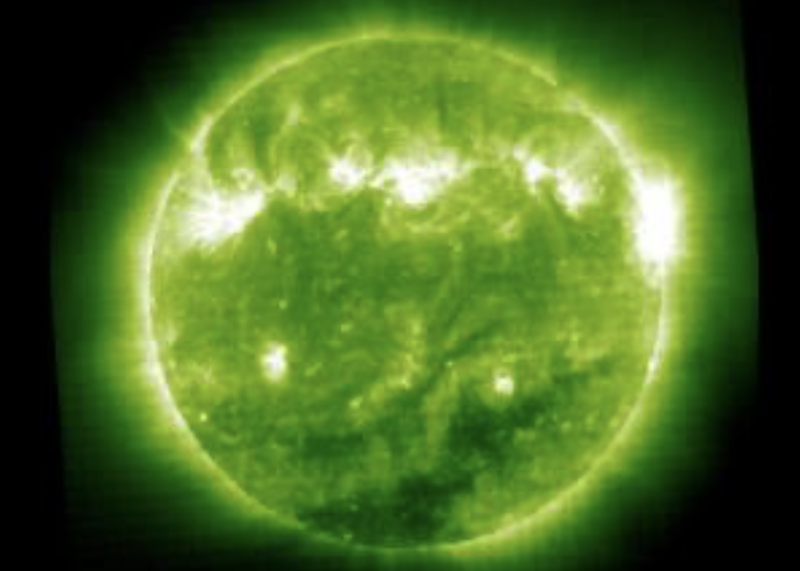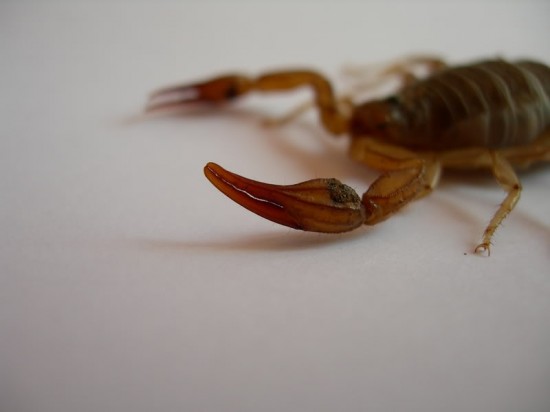
Zubeneschamali, aka Beta Librae, is the brightest star in the constellation Libra the Scales. It’s just a touch brighter than the other bright star in Libra, called Zubenelgenubi. Modern observers – and we’re talking about professional astronomers now – often say that the star Zubeneschamali in the constellation Libra is white or bluish. But earlier observers often described Beta Librae as a green star. For example, the incomparable Burnham’s Celestial Handbook quotes the famous amateur astronomer Willian Tyler Olcott (1873–1936) on this subject. Olcott referred to Zubeneschamali as:
… the only naked-eye star that is green in color.
Many stargazers agree. Others don’t. So is Zubeneschamali green?
According to scientists, we don’t see green stars. Stars emit a spectrum (“rainbow”) of colors, including green. But – within the range of wavelengths and intensities found in stars – greens get mixed with other colors. And so the star appears white.
For stars, the general colors are, from lower to higher temperatures, red, orange, yellow, white and blue.
And there are no green stars, according to scientists. Physicist Ben Bartlett delves into the details of why stars can’t be green in the the comments associated with the following tweet.
Be sure to click on the comments icon to get to this conversation.
As stars burn hotter and hotter, they go from looking red to orange to yellow to white to blue…
But why are there no green stars?? [1/4] pic.twitter.com/4pRFmv7ojF
— Ben Bartlett (@bencbartlett) November 10, 2020
Bartlett also has a neat animation to help you visualize why stars don’t look green.
So scientists can explain to you why stars can’t look green.
Yet many stargazers swear that Zubeneschamali proves otherwise.
Look for yourself. If Zubeneschamali doesn’t appear green to your unaided eye, try binoculars. Have your friends look at this star too. You might at least discover that people see colors differently.
How to find Zubeneschamali
Check this star out for yourself on a Northern Hemisphere summer evening. Assuming you’re in the Northern Hemisphere, it shines high in your southern sky each summer and is easy to find.
Look for Zubeneschamali a good two fist-widths to the northwest (upper right) of the brilliant ruddy star Antares in the constellation Scorpius – one of the few constellations that look like the creature for which it was named. Hold your fist an arm’s length away.
Zubeneschamali is slightly brighter than its brother star Zubenelgenubi. But Zubenelgenubi is designated as the alpha star of the constellation Libra. Why? It might be because the other star, Zubenelgenubi, sits squarely on the ecliptic, the annual pathway of the sun in front of the background stars.

History and mythology of Zubeneschamali
Both of these star names – Zubeneschamali and Zubenelgenubi – rhyme with Obi-Wan Kenobi of Star Wars fame.
They are Arabic phrases meaning the Northern Claw (of the Scorpion) and the Southern Claw (of the Scorpion), respectively. Many thousands of years ago in ancient Babylon, these two stars once belonged to the constellation Scorpius the Scorpion, and once depicted the Scorpion’s outstretched claws.
Apparently, the ancient Greeks and Romans redrew the boundaries, creating the constellation Libra the Scales. Well over 2,000 years ago, the sun on the autumn equinox shone in front of Libra, the balance symbolizing the equal duration of day and night on the equinox. At present, the sun is in front of the constellation Virgo the Maiden on the autumn equinox, which falls annually on or near September 22.
In the star lore of the ancient Greeks, the constellation Virgo represents Astrea, the goddess of justice, holding Libra the Scales and weighing judgment upon human souls. It’s thought that Roman citizens associated Libra with Augustus, the dispenser of divine judgment.


Zubeneschamali science
Science has helped Zubeneschamali to one-up its biggest rival in Libra, the alpha star Zubenelgenubi. Astronomers have determined that Libra’s beta star is considerably brighter intrinsically than its rival Zubenelgenubi.
Yet these two Libra stars appear nearly the same brightness as seen from Earth. Why? It’s because Zubenelgenubi lies at less than half Zubeneschamali’s distance. Zubenelgenubi is 77 light-years away. Zubeneschamali is 160 light-years away.
Zubeneschamali’s intrinsic luminosity is nearly five times that of Zubenelgenubi and 130 times that of the sun.
Zubeneschamali’s position: RA: 15h 17.5m, dec: -9° 25′

Bottom line: Is Zubeneschamali green? Learn about this brightest star in the constellation Libra.
The post Is Zubeneschamali a green star? first appeared on EarthSky.
from EarthSky https://ift.tt/3zQDMqm

Zubeneschamali, aka Beta Librae, is the brightest star in the constellation Libra the Scales. It’s just a touch brighter than the other bright star in Libra, called Zubenelgenubi. Modern observers – and we’re talking about professional astronomers now – often say that the star Zubeneschamali in the constellation Libra is white or bluish. But earlier observers often described Beta Librae as a green star. For example, the incomparable Burnham’s Celestial Handbook quotes the famous amateur astronomer Willian Tyler Olcott (1873–1936) on this subject. Olcott referred to Zubeneschamali as:
… the only naked-eye star that is green in color.
Many stargazers agree. Others don’t. So is Zubeneschamali green?
According to scientists, we don’t see green stars. Stars emit a spectrum (“rainbow”) of colors, including green. But – within the range of wavelengths and intensities found in stars – greens get mixed with other colors. And so the star appears white.
For stars, the general colors are, from lower to higher temperatures, red, orange, yellow, white and blue.
And there are no green stars, according to scientists. Physicist Ben Bartlett delves into the details of why stars can’t be green in the the comments associated with the following tweet.
Be sure to click on the comments icon to get to this conversation.
As stars burn hotter and hotter, they go from looking red to orange to yellow to white to blue…
But why are there no green stars?? [1/4] pic.twitter.com/4pRFmv7ojF
— Ben Bartlett (@bencbartlett) November 10, 2020
Bartlett also has a neat animation to help you visualize why stars don’t look green.
So scientists can explain to you why stars can’t look green.
Yet many stargazers swear that Zubeneschamali proves otherwise.
Look for yourself. If Zubeneschamali doesn’t appear green to your unaided eye, try binoculars. Have your friends look at this star too. You might at least discover that people see colors differently.
How to find Zubeneschamali
Check this star out for yourself on a Northern Hemisphere summer evening. Assuming you’re in the Northern Hemisphere, it shines high in your southern sky each summer and is easy to find.
Look for Zubeneschamali a good two fist-widths to the northwest (upper right) of the brilliant ruddy star Antares in the constellation Scorpius – one of the few constellations that look like the creature for which it was named. Hold your fist an arm’s length away.
Zubeneschamali is slightly brighter than its brother star Zubenelgenubi. But Zubenelgenubi is designated as the alpha star of the constellation Libra. Why? It might be because the other star, Zubenelgenubi, sits squarely on the ecliptic, the annual pathway of the sun in front of the background stars.

History and mythology of Zubeneschamali
Both of these star names – Zubeneschamali and Zubenelgenubi – rhyme with Obi-Wan Kenobi of Star Wars fame.
They are Arabic phrases meaning the Northern Claw (of the Scorpion) and the Southern Claw (of the Scorpion), respectively. Many thousands of years ago in ancient Babylon, these two stars once belonged to the constellation Scorpius the Scorpion, and once depicted the Scorpion’s outstretched claws.
Apparently, the ancient Greeks and Romans redrew the boundaries, creating the constellation Libra the Scales. Well over 2,000 years ago, the sun on the autumn equinox shone in front of Libra, the balance symbolizing the equal duration of day and night on the equinox. At present, the sun is in front of the constellation Virgo the Maiden on the autumn equinox, which falls annually on or near September 22.
In the star lore of the ancient Greeks, the constellation Virgo represents Astrea, the goddess of justice, holding Libra the Scales and weighing judgment upon human souls. It’s thought that Roman citizens associated Libra with Augustus, the dispenser of divine judgment.


Zubeneschamali science
Science has helped Zubeneschamali to one-up its biggest rival in Libra, the alpha star Zubenelgenubi. Astronomers have determined that Libra’s beta star is considerably brighter intrinsically than its rival Zubenelgenubi.
Yet these two Libra stars appear nearly the same brightness as seen from Earth. Why? It’s because Zubenelgenubi lies at less than half Zubeneschamali’s distance. Zubenelgenubi is 77 light-years away. Zubeneschamali is 160 light-years away.
Zubeneschamali’s intrinsic luminosity is nearly five times that of Zubenelgenubi and 130 times that of the sun.
Zubeneschamali’s position: RA: 15h 17.5m, dec: -9° 25′

Bottom line: Is Zubeneschamali green? Learn about this brightest star in the constellation Libra.
The post Is Zubeneschamali a green star? first appeared on EarthSky.
from EarthSky https://ift.tt/3zQDMqm

Aucun commentaire:
Enregistrer un commentaire